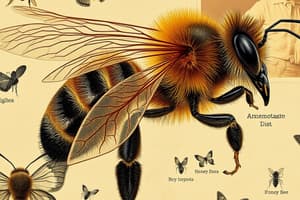Podcast
Questions and Answers
Which physical characteristic most contributes to the honey badger's toughness?
Which physical characteristic most contributes to the honey badger's toughness?
- Innate resistance to venom.
- Remarkable eyesight for hunting in low light.
- Exceptional climbing ability.
- Thick, loose skin that is difficult to penetrate. (correct)
Besides defense, what is another primary use of a honey badger's claws?
Besides defense, what is another primary use of a honey badger's claws?
- Digging for food and creating shelters. (correct)
- Grooming and removing parasites from their fur.
- Maintaining balance while climbing trees.
- Signaling to other honey badgers.
What might a honey badger do if a much larger animal approaches its den?
What might a honey badger do if a much larger animal approaches its den?
- Attempt to intimidate and attack the larger animal, regardless of size. (correct)
- Play dead to avoid confrontation.
- Lure the animal away from the den by feigning injury.
- Mimic the sounds of a more dangerous predator to scare it away.
What is the approximate length of a tunnel a honey badger can dig in about 10 minutes?
What is the approximate length of a tunnel a honey badger can dig in about 10 minutes?
What is the only area on a honey badger's body where they can be safely gripped?
What is the only area on a honey badger's body where they can be safely gripped?
Which of the following is NOT explicitly mentioned as a prey of the honey badger?
Which of the following is NOT explicitly mentioned as a prey of the honey badger?
Why is a honey badger's loose skin advantageous in a fight?
Why is a honey badger's loose skin advantageous in a fight?
Based on the information, what is the most likely reason honey badgers are called 'honey' badgers?
Based on the information, what is the most likely reason honey badgers are called 'honey' badgers?
A wildlife researcher observes a conflict where a honey badger successfully steals a kill from a cheetah. Which aspect of the honey badger's behavior is BEST demonstrated by this observation?
A wildlife researcher observes a conflict where a honey badger successfully steals a kill from a cheetah. Which aspect of the honey badger's behavior is BEST demonstrated by this observation?
Imagine a new species of armored snake is discovered whose scales are impervious to the claws of most digging mammals. How might this adaptation affect the hunting success of honey badgers in areas where this snake is prevalent?
Imagine a new species of armored snake is discovered whose scales are impervious to the claws of most digging mammals. How might this adaptation affect the hunting success of honey badgers in areas where this snake is prevalent?
Flashcards
Honey Badger
Honey Badger
A mammal known for its toughness, found in Africa and western Asia.
Honey Badger Reputation
Honey Badger Reputation
Honey badgers possess a reputation for toughness that is far greater than their size.
Honey Badger Skin
Honey Badger Skin
The honey badger's skin is thick, loose, and tough, providing significant protection.
Loose Skin Advantage
Loose Skin Advantage
Signup and view all the flashcards
Honey Badger Claws
Honey Badger Claws
Signup and view all the flashcards
Honey Badger Digging
Honey Badger Digging
Signup and view all the flashcards
Honey Badger Diet
Honey Badger Diet
Signup and view all the flashcards
Honey Badger Homes
Honey Badger Homes
Signup and view all the flashcards
Honey Badger Fearlessness
Honey Badger Fearlessness
Signup and view all the flashcards
Honey Badger Territoriality
Honey Badger Territoriality
Signup and view all the flashcards
Study Notes
- The honey badger is considered one of the toughest mammals in Africa and western Asia.
- Honey badgers are less than a foot high, a couple of feet long, and weigh just over 20 pounds.
- Despite their small size, they have a reputation for toughness - some even chase away lions and take their kills.
Honey Badger Attributes
- Honey badgers possess speed, stamina, and agility.
- Their thick and tough skin protects them from arrows, spears, and bites, and is even resistant to small bullets.
- The skin is loose, allowing them to twist and attack while gripped by another animal.
- The only safe grip on a honey badger is on the back of their necks.
- They have long, sharp claws for attacking and digging.
- Honey badgers can dig a nine-foot tunnel into hard ground in approximately 10 minutes.
- They dig up the burrows of frogs, rodents, and cobras for food and create underground chamber homes.
- They fiercely defend their dens, and will attack larger animals like horses, cows, and water buffalo if they approach them.
Studying That Suits You
Use AI to generate personalized quizzes and flashcards to suit your learning preferences.



